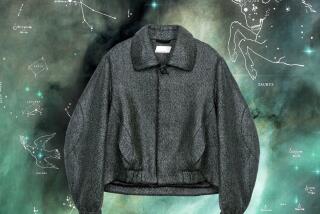Ski Wear Off the Slopes, Onto the Streets
Susie Wiyninger has plastered the bulletin boards in her office with a colorful collection of paper dolls.
A few of her co-workers sit around her massive desk, coloring small drawings of jackets and pants with felt pens.
This might look like child’s play, but it’s really business.
Snow business.
The paper dolls are actually Wiyninger’s designs for the 1990-’91 line of ski fashions for Nils Skiwear in Fountain Valley.
Her colorful, sleek ski jackets proved so popular this season that despite a dry winter, Nils powdered off $7 million in sales, proof that today’s high-fashion ski jackets are not just for skiing.
“It was the biggest reorder year we’ve ever had, even with the lack of snow,” Wiyninger says. “People are wearing the jackets everywhere.”
With their body-conscious silhouettes and bright colors, parkas have come down from the mountains and onto the streets.
On a cool Orange County day, they can be worn as casual cover-ups or elegant evening jackets.
“West Coast women are wearing them shopping, to football games and out in the evening,” Wiyninger says.
The parka has changed shape since she began designing ski wear 15 years ago.
Gone are the bulky, quilted jackets that made even a skinny person look, in Wiyninger’s words, “like a big Michelin man.”
Thanks to the development of lightweight insulation and pliant nylon fabrics, designers can create jackets with draped or fitted looks.
“We can make the jackets real slim-fitting,” she points out.
That especially appeals to women, who want jackets that flatter the figure instead of padding it in thick down. Men, meanwhile, like the bomber-style jackets with a lot of functional gizmos.
“Men want all the bells and whistles,” Wiyninger says. “They want the hoods, the goggle holders and all the pockets.”
Snow bunnies have good reason to want to show off their parkas off the slopes and far away from the ski lodge. With all of the high-tech materials, the cover-ups can cost as much as an expensive evening jacket--often $500 or $600, depending on the insulation.
With the pricey insulations come lighter jackets in a wider range of styles.
Men and women can find everything from short, fitted jackets to longer coats that fall to the hip or thigh, often accenting the waist with a cinch belt or drawstring.
Some parkas look like they’re ready for space travel, with funky, asymmetrical zipper openings, funnel collars that shroud the neck, and lots of pouches adorning the sleeves and front.
One of Wiyninger’s more popular styles this season is a short-waisted, form-fitting jacket that comes in day-glo shades of nylon with a black, asymmetrical zipper opening in front, a funnel collar and black-ribbed knit hugging the waist and cuffs.
Shell jackets that have no insulation but still provide protection from the water and wind have been hot sellers in warmer climates.
A comfortable cover-up by the Obermeyer label, for instance, comes in a lightweight embossed purple satin that falls loosely to the hips with a drawstring waist. It has a contrasting hood lined in turquoise, available for $139.95 at the Newport Ski Co. in Newport Beach.
“There’s no way you can’t wear that off the slopes,” says Vicki Vultee, manager of Newport Ski.
The ski shop also carries insulated jackets by Skea that can be worn for a night on the town, including a bomber-style jacket with an abstract gold pattern stamped on black nylon for $554, and lightweight hooded jackets in satiny jewel tones such as emerald green, fuchsia and purple for $359.95.
For men, there’s a Top Gun-style jacket by Descente made of a silver metallic, polyester-nylon blend with black pseudo-suede trim for $589.
Fabrics that have blazing colors and textured prints or glossy satin weaves have helped transform the parka into a designer garment.
Wiyninger uses nylons treated with resin to create an ethnic texture, and cross-dyed fabrics that shimmer in two tones, such as hot pink blended with blue to get an iridescent periwinkle.
Enrico Coveri of Italy introduced women’s bomber jackets with a variety of unusual prints, including one made from a multicolored, tie-dyed nylon and another in soft white flannel with bright ethnic trim on the shoulders and side panels, both for about $590 at La Patou in Newport Beach.
Funky computer prints with abstract dots and stripes decorate a line of jackets for men by Luhta, which sell for about $300.
The acidic neons seen on most ski wear mark a “transitional year” for the industry, according to Wiyninger.
While new looks for the 1990-’91 season won’t be unveiled until the annual ski wear show in Las Vegas in March, most American designers will probably follow the lead of the Europeans and create jackets in more muted colors, she says.
Instead of ultra-bright neons, she’s chosen swatches of neon coral, washed-out lime, light teal and peacock blue. Occasionally, jackets that look good when they’re eight inches tall and colored in felt pen look entirely different when they’re transformed into fabric. Some never make it to the slopes.
“Sometimes I look at the finished sample and go, ‘Did I do that?’ ” Wiyninger says.
Then it’s back to making paper dolls.






